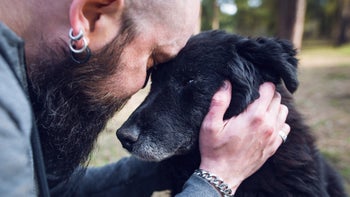
Dog Seizures: Learn the Signs and What to Do
Key takeaways:
Signs of a dog seizure include vomiting, circling, becoming clingy, and vocalizing. If your dog has a grand mal seizure, it can affect their full body, and they may lose consciousness.
Seizures in a dog look scary, but they are often brief and don’t typically cause your pet any pain.
If you suspect a seizure, pay close attention to your dog, remove anything that can harm them, and call your veterinarian.
Table of contents

Like cats and humans, dogs can have seizures. These seizures happen when there’s unusual electrical activity in a dog’s brain.
It’s alarming for pet parents to witness their pup having a seizure. But it isn’t usually as traumatic for the animal. A dog seizure, which involves muscle spasms and involuntary movement, typically lasts from a few seconds to a few minutes.
Keep reading to learn the signs of a dog seizure, what causes seizures in dogs, and how to prevent and treat this condition.
Save on the top 10 pet medications
Save big on common pet medications like Fluoxetine and Levetiracetam at your local pharmacy.

GoodRx is NOT insurance. GoodRx Health information and resources are reviewed by our editorial staff with medical and healthcare policy and pricing experience. See our editorial policy for more detail. We also provide access to services offered by GoodRx and our partners when we think these services might be useful to our visitors. We may receive compensation when a user decides to leverage these services, but making them available does not influence the medical content our editorial staff provides.
What does a dog seizure look like?
Dog seizure symptoms can look different depending on the dog and type of seizure. Common signs of seizures in dogs include:
Staring into space
Becoming restless or clingy
Salivating
Snapping their jaw
Producing loud vocalizations
Circling
Types of seizures in dogs
There are different types of seizures in dogs. Some impact just one part of a dog’s body. Others affect a dog’s entire body.
Focal seizure
A localized seizure, or focal seizure, affects only one part of a dog’s body. You might notice a facial tremor or sudden rhythmic movement of a single limb or body part, for example.
Other signs of a focal seizure include:
Fly-biting, where the dog seems to be trying to snap at flies
Chewing gum fit, where the dog’s jaw clacks repeatedly
Twitching eyelids, ears, or lips
Paying for seizure treatment: Learn how one dog owner was able to afford treatment for her dog with epilepsy. She may have some tips that can help you, too.
Keppra for dogs: Keppra (levetiracetam) is one medication your dog may be given for seizures. Read up on what to expect from this seizure treatment.
Human medications for dogs: Your dog can take some of the same seizure medications as humans. Here’s how to fill these prescriptions for your pet.
A dog experiencing a focal seizure may not lose consciousness. And treatment may not be necessary. But some focal seizures can turn into generalized, or grand mal, seizures. So it’s best to keep an eye on your dog until the seizure passes.
Grand mal seizure
During a grand mal seizure, a dog’s entire body convulses. These seizures are easier to identify than focal seizures and can look severe. Common grand mal seizure symptoms in dogs include:
Losing consciousness
Becoming unresponsive
Paddling their limbs
Pulling their head backward
Urinating or defecating involuntarily
Read more like this
Explore these related articles, suggested for readers like you.
Cluster seizures
Dog seizures can occur as a single event or as multiple seizures, called a cluster. Cluster seizures are defined as those that occur more than once in a 24-hour period.
What causes seizures in dogs?
Seizures in dogs can be caused by a number of things, according to Jennifer Frione, DVM, the owner of Lakeside Animal Hospital in Florida. This includes:
Structural issues within the brain caused by brain tumors, trauma, or infection
Health issues, such as hypoglycemia (low blood sugar), exposure to toxins, liver disease, or kidney disease
Infections, such as distemper
Idiopathic epilepsy, a condition that has no identifiable cause but leads to recurring seizures
If dogs start having seizures between 6 months and 6 years old, veterinarians often can’t identify a cause. These dogs are usually diagnosed with epilepsy. Dogs who start having seizures after 5 years of age are more likely to have seizures due to brain tumors.
Dog seizure triggers
Triggers for seizures in dogs aren’t well studied. But some research suggests that the following may trigger seizures in dogs with epilepsy:
Lack of sleep
Stress
Changes at home
Weather changes
Hormones
What to do when your dog has a seizure
If your dog has a seizure, there are steps you can take to monitor your pup and keep them safe.
Try to stay calm
It’s important to remain calm, and don’t try to interrupt the seizure. You can’t stop a seizure in your dog immediately. Keep in mind that your dog is likely not in pain, even if they sound like it.
“When a dog has a seizure, to prevent suffering, remove surrounding objects that a pet may injure themselves on,” Frione recommended. If it’s safe, gently move them out of harm’s way, such as away from stairs or bodies of water.
Keep your hands away from their mouth
Do not attempt to grab your dog’s tongue, as there’s a chance you may be bitten. Dogs don’t swallow their tongues during a seizure.
Keep your pup cool
Seizures that last longer than 5 minutes can put dogs at risk of overheating. You can try cooling your dog by wetting towels with cool — not freezing-cold — water. If you can do so safely, place the towels around your dog’s neck, paws, or head.
Overheating is life-threatening and needs to be treated in a hospital as soon as possible.
Record the seizure
Try to record your dog’s seizure on your phone. This way you can show it to your veterinarian. You may also want to log the event in a journal. Keep track of:
When the event took place
The length of the seizure
Exactly what happened
How often the seizures occur
Any recent trauma or injuries
If your dog was exposed to any toxins recently
This valuable information will help your veterinarian diagnose the cause of your dog’s seizure.
What should you do after your dog has a seizure?
Your veterinarian will let you know the best course of action following your dog’s seizure. If your dog is diagnosed with a condition that causes regular seizures, your vet will also let you know what to do if they have additional seizures.
If your dog has a first-time seizure or has multiple seizures within 24 hours, consider this an emergency. “Seek veterinary care immediately if your pet does not have a history of seizures [or] is having cluster seizures or prolonged grand mal seizures,” Frione said.
After a seizure, your dog may be disoriented or confused for a period of time. They may exhibit behaviors such as:
Hunger
Fatigue
Keep your dog calm after a seizure, and continue to monitor their symptoms. Look for signs your dog’s behavior is returning to normal. If you have any concerns, contact your veterinarian.
How do you treat a dog seizure?
Dog seizure treatment depends on the cause. But many dogs with seizures will be treated with medications.
Seizure medications
Your dog may need to take anticonvulsant medications if they have a seizure that lasts over 5 minutes or they have multiple seizures in a short time frame. Seizure medications your veterinarian may prescribe for your dog include:
Levetiracetam (Keppra)
Zonisamide (Zonegran)
Medications can help control the number and severity of seizure episodes, Frione said. But keep in mind that medications won’t necessarily stop your dog’s seizures completely.
Phenobarbital can take up to 2 weeks to take full effect. Your vet may prescribe higher doses in the first 24 hours so your dog benefits from the medication faster. How long your dog needs to take seizure medication will depend on your dog and the specific medication. Your pup may also need follow-up bloodwork after starting a medication.
“The length of treatment will be based on what medications are prescribed. However, once a pet is put on anticonvulsants, they are usually required for life,” Frione said. In these cases, it is possible for dogs to have a seizure if even a single dose of the medication is missed.
Surgery
If your dog’s seizures are a result of a brain tumor, surgery to remove the tumor may reduce the seizures. If the tumor is found early, radiation treatment might be an option instead of surgery. Dogs who aren’t able to undergo surgery may be given steroids like prednisone to help reduce brain swelling.
Treating underlying issues
If your dog’s seizures are caused by low blood sugar or liver or kidney diseases, treating the underlying condition may reduce the seizures.
If toxins are determined to be the cause of a seizure, your vet will recommend an appropriate treatment. Be sure to remove the toxin or poison from your dog’s environment so they don’t get into it again.
Frequently asked questions
Status epilepticus is an emergency situation where dogs experience seizures for more than 5 minutes without stopping. Or they may have more than one seizure within 5 minutes without recovering to their normal selves between seizures.
Like humans, dogs twitching in their sleep is usually caused by dreaming. If your dog seems very stiff or pees, poops, or vomits in their sleep, it might be best to take them to the vet. These could be signs of a health issue. If you have an older dog and they seem to shake in one area, it could be from pain or arthritis.
In most cases, you can’t fully prevent your dog from having seizures. But you can try to reduce the frequency of their seizures by going to regular veterinary checkups, keeping them on their medications, and reducing their known seizure triggers.
The bottom line
Seizures in dogs can be treated and managed with prompt medical attention and careful observation during and after the seizures. During a seizure, stay calm and focused. Letting your pet handle the event on their own is usually recommended. There is no way to prevent your dog from having a seizure. But regular veterinary checkups can help identify any underlying conditions that could cause seizures.
Why trust our experts?



References
Brooks, W. (2023). Tremoring or shivering in dogs. Veterinary Partner.
Brooks, W. (2024). Seizure disorders in dogs. Veterinary Partner.
Brooks, W. (2025). Potassium bromide (K-BroVet). Veterinary Partner.
Forsgård, J. A., et al. (2018). Seizure‐precipitating factors in dogs with idiopathic epilepsy. Journal of Veterinary Internal Medicine.
North Carolina State University College of Veterinary Medicine. (n.d.). Neurology: Brain tumors in dogs and cats.
Richard P. Riney Canine Health Center. (n.d.). Managing seizures. Cornell University.
Scislowicz, O. D. (2015). Epileptic emergencies: Status epilepticus in canine patients. Today’s Veterinary Practice.
Yanke, A. B. (2018). Seizure management for the small animal practitioner. Auburn University College of Veterinary Medicine Annual Conference.




























